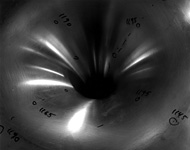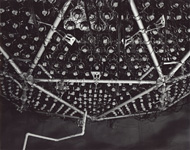Via Symmetry Magazine
-----

Cockroft Walton, KEK, Ibariki, Japan, 2008
From ATLAS to Antarctica, photographer Stanley Greenberg has
travelled the world in a high-energy treasure hunt for the shapes of
physics. In a book of photographs to be published next year, Greenberg
will show the results of his five-year photography tour of detectors and
accelerators across the United States, Canada, Switzerland, Germany,
Italy, Argentina, Japan and Antarctica.
The book’s title, “Time Machines,” refers to the experiments’ efforts
to recreate the period just after the big bang. Yet the photos
themselves create something of a time warp effect: the most high-tech
equipment in the world shot on black and white film.
Greenberg, who has already published two photography books on New
York City’s infrastructure and architecture under construction around
the country, was impressed by the structural forms and large spaces that
comprise detectors.
“It’s an extra feature that there’s all this incredible research going on,” he said.
A self-described science nerd, Greenberg became interested in the LHC
when it was under construction in 2005 and contacted a Columbia
University physicist to ask about photographing it. She put him in touch
with some of her colleagues at CERN and from other laboratories, all of
whom were happy to open their doors to Greenberg. Grants from the Sloan
Foundation and the National Science Foundation allowed him to travel
wherever he wanted among the world’s high-energy physics experiments.
“I started to live and breathe physics for a while,” Greenberg said.
“When it quickly becomes an obsession, you know that you’re going to
stick with it.”
His network quickly expanded as each physicist referred him to
friends at other collaborations. Eventually, physicists he’d never even
heard of emailed him, asking when he was coming to photograph their
experiments. Their openness, he said, was a “welcome change” from his
previous projects photographing NYC’s underground where getting access
to the structures was difficult, if not impossible.
The teamwork that exists in high-energy physics collaborations,
Greenberg said, was one of the most interesting things about the
project.
“It’s such a perfect model for so many other things,” he said.
“People from 15 different countries can work on one project and get
along.”
Their hospitality allowed him many unique views for his shots and
experiences such as climbing around inside the LHC’s ATLAS and ALICE
experiments while they were still under construction.
“Even getting to some of these places was amazing,” he said. “At
SNOLAB, first you’re dressed like a miner, then you’re dressed like a
lab technician, then you get dropped a few hundred feet by a rope. It’s
not the kind of thing you forget too quickly.”
Nor was the richness of the assortment of remote locales lost on Greenberg.
“I like to go to places where you’re the only one that’s there,” he
said. “I’ve been to the bottom of a mine, inside a mountain, to the edge
of the world.”
To learn more about “Time Machines” and view Greenberg’s previous work, visit www.stanleygreenberg.net.
To see more photos from "Time Machines," click on the thumbnail images below.
 |
 |
 |
| MiniBooNe Horn, Fermilab, Illinois, 2006. Click to see full-size image. |
CEBAF Large Acceptance Spectrometer, Jefferson National Laboratory, Virginia, 2008 |
Cockroft Walton, J-PARC, Ibariki, Japan, 2008 |
|
|
|
 |
 |
|
| SNO, SNOLab, Ontario, 2009 |
ICECUBE Drilling Station, Antarctica, 2009 |
|
|
-----
Personal comment: the exhibition is @MIT Museum, Cambridge, MA until the 17th of March, 2014.






